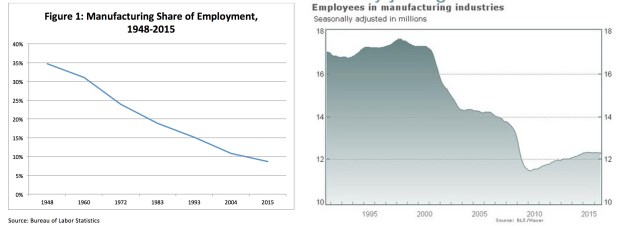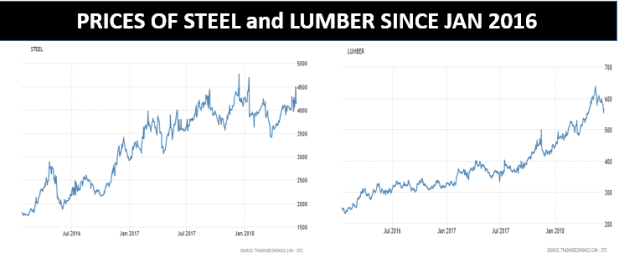“The Chinese are raping us” and “Canada is killing our farmers”! Such melodramatic claims from Trump resonate with many Americans, because the effects of globalization have been devastating for half the population. To his credit, Trump has been harping on trade deficit for thirty years – he was complaining about the Japanese in the 1980s. However, he’s vastly oversimplifying the issue and the solutions. This is an important topic that requires serious thoughts.
What is Trade Deficit?
Simply put, trade balance is the difference between our exports and imports. If we export more than we import, we have a trade surplus; but if we import more than we export, alas, we have a trade deficit!
Why Trade Deficit is Bad
Trade deficit is transfer of wealth.
Since our Federal Reserve Bank creates fiat money out of thin air, it’s hard to see the adverse effects of trade deficits. However, imagine for a moment that all trade happened with gold. Every year that we have a trade deficit, our gold reserves will shrink, and we can then clearly see that perpetual trade deficit is unsustainable.
Another facet of trade deficit is its impact on the money supply. Say you spend $1000 on jewelry at a local store. That’s not a one-time transaction. The jeweler may spend that money on a furniture store, whose owner uses that money to pay his employee, who uses that to pay his rent, which the landlord uses to buy grocery, and so on. Thus the economic effect of $1000 is multiple times its value.
Now imagine the catalytic effect of $9 trillion! That’s the tremendous economic stimulus we have lost in the last two decades alone due to trade deficit.

Symptom of Jobs Lost
A corollary of trade deficit is that Americans are not producing the goods that we import. Of course, no country is 100% self-reliant, but everything we import potentially represents a lost American job.
Blame China? Not so Fast!
Blaming China, which is also a rising economic superpower, is a political winner. Yes, we have the largest trade deficit with China – about $380 billion – but that number is fake.
Look at an iPhone that’s assembled in China and shipped to the US. Our commerce department will claim a US-China trade deficit of about $600. In reality, China gets only about $40 out of that $600, since a Chinese company merely assembles various expensive parts from Japan, South Korea, Taiwan etc.
Thus, our true trade deficit with China is about half the official number.
But the Math Keeps Getting Murkier!
Trade deficit also fails to include the effects of overseas operations, foreign investments etc.
Consider that GM sells more cars in China than in the US. GM’s profit from those cars represent a transfer of wealth from China to the US. Similarly, US corporations such as Starbucks, McDonald’s, KFC, clothing brands, hotel chains etc. have tens of thousands of branches all over the world. Profits from all such activities are ignored in the trade deficit numbers.
Furthermore, when foreigners buy homes in the US, purchase shares of US corporations, acquire entire firms, or open a factory in the US, those investments aren’t reflected in the import-export statistics either.
Perhaps we need to come up with a new metric that’s more sophisticated.
Who to Blame?
There’s no doubt that the US manufacturing has been decimated over the years. In the 1950’s, the US produced 80% of world’s steel and cars; today, the shares are 5% and 10% respectively. The number of people in the manufacturing sector has steadily fallen over the decades and tens of thousands of manufacturing plants have been closed.

The only people to blame for this are the US corporate elites. They are the ones who championed globalization and wrote NAFTA and WTO. For them, the only difference between a Mexican and an American worker is that the former costs less and hence is a better employee. Walmart buys $60 billion worth of Chinese goods every year, because the executives only care about maximizing their compensation and satisfying the major shareholders.
Interestingly, neither Trump nor any politician dares to challenge the corportocracy that rules the West.
Can Tariffs Help?
Tariffs are deliberate taxes and protectionist measures that make goods from other countries more expensive. They are usually helpful in nations that lack mature markets – for example, in the 19th century, the US benefited from high tariffs, which protected fledgling industries from European competitors.
Right now, guess who demands low tariffs on imports? Apple, Walmart, Home Depot, Starbucks, Ford and most other big firms that rely upon cheap raw materials, labor, intermediate goods and finished goods from other nations.
Given that tariffs should be used only in special circumstances, Trump’s tariffs on lumber and steel are quite misguided. Look at the prices of steel and lumber over the last two years – do these two industries need protection from foreign competition?

Trump’s tariffs will only hurt the average American by raising the prices of many consumer goods – for example, thanks to his tariff, washing machines’ prices are up 19% this year.
Furthermore, retaliatory tariffs from China, Canada and EU are coming soon and will hurt US farms and businesses.
Petrodollar – The Elephant in the Room
In the discussions about trade deficit, there’s a shocking fact that everyone ignores: after WWII, globalists built an international financial system that needs the US to run massive trade deficits! Look at the dominance of US dollar in foreign exchange reserves held by central banks around the world:
How are those countries going to accumulate US dollars and US treasuries? Answer: by selling us goods and services.
Similarly, the US created the Petrodollar system in the 1970’s, forcing other nations to buy oil and commodities using US dollars. This system also perpetuates our trade deficit. For example, how’s India going to get USD to buy oil from Saudi Arabia? By running a trade surplus with the US.
Originally, this system worked because of the so-called “petrodollar recycling” – countries like Saudi Arabia would use much of their oil revenues and trade surpluses to buy American products and weapons.
However, as the US manufacturing kept declining over the decades, the dollars from trade surpluses stopped flowing back to the US as it once did.
Without a Trade Deficit
Trump dreams of a world where the US has no trade deficit. However, if that happens:
- USD will no longer be a global reserve or trading currency
- foreigners won’t have USD to buy US treasuries/bonds
- the US government will be forced to slash its expenditure (social security, military etc.)
- we won’t be able to punish our geopolitical enemies through economic sanctions (since they won’t use US$ to conduct trade)
- in other words, the USA won’t be a superpower anymore!
So Complex! What’s the Solution?
The best solution is to produce more American goods that the rest of the world gladly buy without coercion. In order to do that, we need to rebuild a competitive, high-end manufacturing sector. (Note: this also creates numerous white-collar jobs).
The only ones who can revive manufacturing are those who shipped the jobs abroad – i.e. globalist corporations.
In 2017, we imported 8 million cars — 46% of all cars sold in the US. Imagine how many decent American jobs we can create if we manufacture most of those right at home?

This year alone, US corporations plan to spend $800 billion on stock buybacks – which, by the way, used to be illegal until the 1980s. Such financial engineering only inflates the stock market bubble to irrational levels. If the elites are concerned about the long-term prosperity of America, they will instead invest such vast sums of money to create jobs and innovative products at home. Of course, more Americans with higher-paying jobs will help everyone, including the oligarchs.
We should also promote vocational/trade schools where young people, fresh out of high school, can learn valuable skills directly related to manufacturing and other professional jobs.
There are also numerous other efforts that need to be taken by the US government, civil society, and individual Americans to address the systemic problems in our economy. It will take an entire book to discuss all those, and I am in the process of publishing one.
Author: Chris Kanthan
( ![]() Check out Deconstructing the Syrian War, my new e-book on the Syrian war, the most consequential war of recent times)
Check out Deconstructing the Syrian War, my new e-book on the Syrian war, the most consequential war of recent times)

Reblogged this on seachranaidhe1.
LikeLike